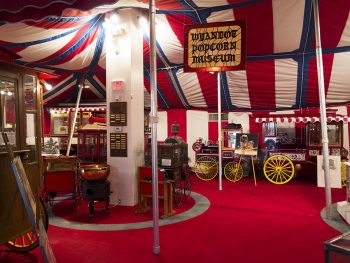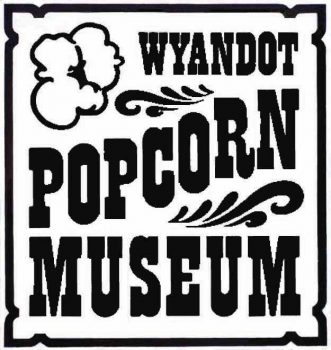 The Wyandot Popcorn Museum opened in early September of 1982, just prior to the 2nd annual Marion Popcorn Festival. Not only is it one of only two Popcorn Museums in the world, it also represents the largest collection of restored popcorn antiques. The Museum concept is an outgrowth of a historical research project by George K. Brown.
The Wyandot Popcorn Museum opened in early September of 1982, just prior to the 2nd annual Marion Popcorn Festival. Not only is it one of only two Popcorn Museums in the world, it also represents the largest collection of restored popcorn antiques. The Museum concept is an outgrowth of a historical research project by George K. Brown.
The creation of the Wyandot Popcorn Museum occurred as a byproduct of research that was done in the early 1970’s and 1980’s on the history of the Wyandot Popcorn Company and the popcorn industry. Thirty years worth of accumulated data fills up two filing cabinets. This included a mass of material on early popcorn machine manufacturers.
In its early years, the Wyandot Popcorn Company was located in a one-room schoolhouse built in 1882. W. Hoover Brown, the founder of the company, attended this school. At first, it seemed fitting to locate the Wyandot Popcorn Museum in this one-room schoolhouse. The acquisition of various beautiful popcorn machine antiques began in the early 1980’s, but it soon became apparent that the collection exceeded the space available in the schoolhouse.

Wyandot, Inc. was in the process of adding office space at their snack plant at 135 Wyandot Avenue. In order to keep the Wyandot Popcorn Museum from being a heavy financial drain, it was to be combined with a factory outlet store for Wyandot’s consumer raw popcorn and snack products. This opened in 1981. The initial collection included donated, loaned, and purchased antiques from all areas of the country. A customer in Canada donated a commercial popper used by Suzan Popcorn in Cherbrooke, Quebec. The popper was being used to manufacture caramel corn at the time of its donation to the museum. The antique originally came from the now-defunct Long-Eakin Company in Springfield, OH. Mr. Long started the company and Mr. Eakin joined him later. The museum’s collection includes a second dry popper from the company, which specialized in caramel patties of sweet popcorn called Crispettes.
The Wyandot Popcorn Museum also acquired a volume tester that was designed and created by the Cracker Jack Company in 1931 to determine the expansion of their popcorn. It shook the grain in a wire basket and measured the expansion in a glass tube. By 1944, C. Cretors & Company worked in conjunction with the Popcorn Processors Association to develop the first Official Volume Tester. One of those first O.V.T. testers is at the museum, as well as its conversion to the weight volume tester in the 1960’s.
Initially, the featured antique was an 1899 Cretors No. 1 wagon–both for its beauty and its age. It is the third oldest surviving Cretors popcorn machine. Since the opening of the Wyandot Popcorn Museum, two older antiques have been acquired. There is an 1896 Kingery steam-driven wagon and an 1892 Olsen store-type dry popper hand-turned with the original patent for a squirrel cage dry popper. There were 35 popcorn and peanut antiques ready for the opening in Marion. The Factory Outlet/Wyandot Popcorn Museum operated at that location until 1985, when the Museum moved to the Southland Mall, where the hours would be better for the public.
After three years at the Southland Mall location, the antiques were placed in various locations around the country so that many people would have the opportunity to see them. Three antique poppers, including a 1915 Kingery walk-in wagon, a 1948 Air Pop automatic vendor, and a 1912 Cretors No. 1 steam wagon went to the Center of Science & Industry (COSI) in Columbus. One antique went to the Snack Food Association in Alexandria, VA. Two antiques went to Paul Newman’s office in Westport, CT. Other local antiques were returned to their owners. The Cretors Model TT Ford Concession Wagon was temporarily stored in George Brown’s barn along with a 1911 Dunbar wagon formerly owned by Paul Newman. The rest of the antiques went to Michael and Linda Perry’s Bed & Breakfast on South State Street in Marion. Most of the first floor of this home was used to display the various antiques.
In 1989, the 90-year-old U.S. Post Office building in downtown Marion was available for purchase. It was an ideal choice for the Marion County Historical Society and the Wyandot Popcorn Museum. The Wyandot Popcorn Museum trustees offered the Marion County Historical Society financial support with the understanding that 40 percent of the main floor would be used for the Wyandot Popcorn Museum.
In nearby Mansfield, an individual was found who owned a collection of ceramic circus items housed in a tent that was 25 by 60 ft with a 12 ft ceiling in red, white, and blue canvas. This idea provided a good solution for the museum’s need for an attractive display and gave the museum a circus theme. The Wyandot Popcorn Museum’s tent is 30 by 75 by 14 ft high. Finally, the museum could show large antique pieces that could not have been on display at previous locations.
The collection includes a Model TT Cretors Popcorn truck that is driven in the Marion Popcorn Festival Parade. In 1990, a horse-drawn 1909 Cretors Model D Popcorn Wagon was acquired. This rare and beautiful unit was one of two Model D wagons used by the Ringling Bros. and Barnum and Bailey Circus. A Cretors Model C Wagon was restored by Bob Pearson of Pearson & company in Olathe, Kansas. This one is identical to the style of wagon used at the court house in Marion at the turn of the century. A Dunbar was purchased from Mr. Koepsell in Milwaukee, Wisconsin, by Paul Newman of Newman’s Own in 1984. Newman utilized to promote his product in Central Park and in supermarket chain demonstrations for several years. He decided, due to vandalism, to sell it to George Brown, who, in turn, donated it to the Wyandot Popcorn Museum.
#MarionMade #WeArePoppin


















